

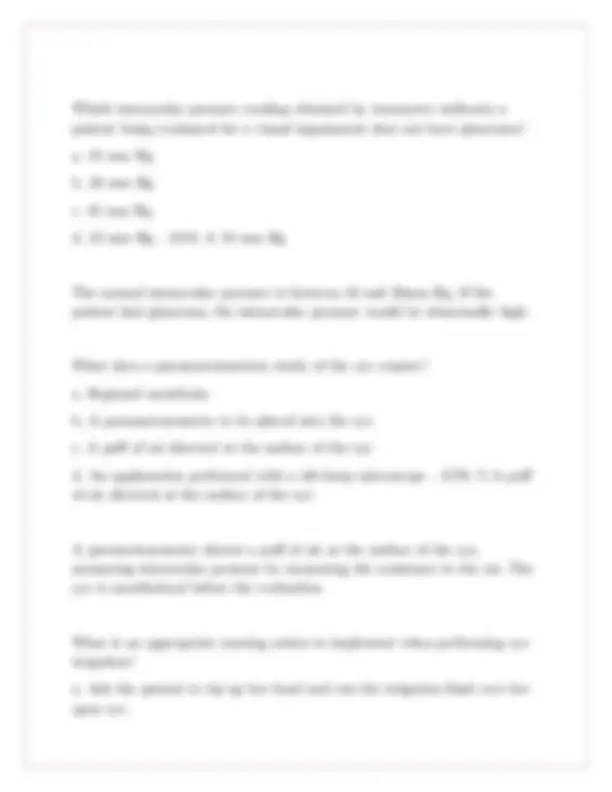
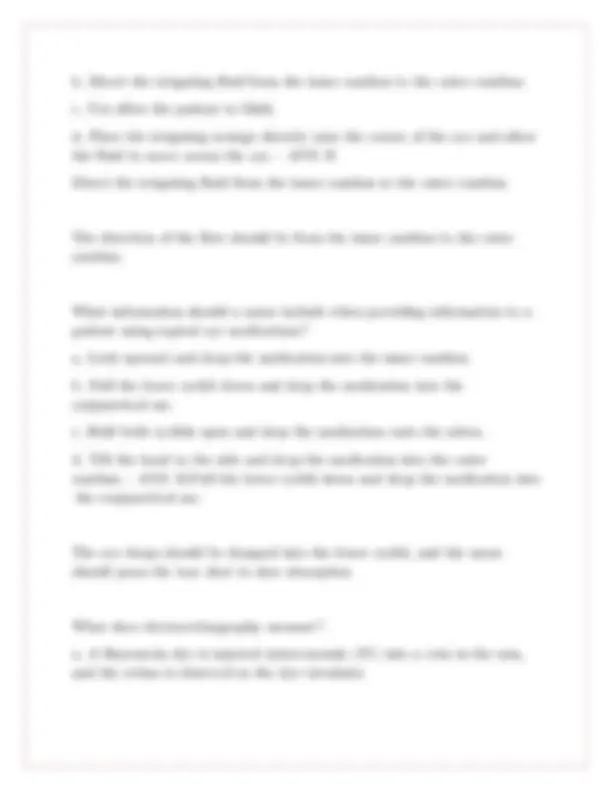
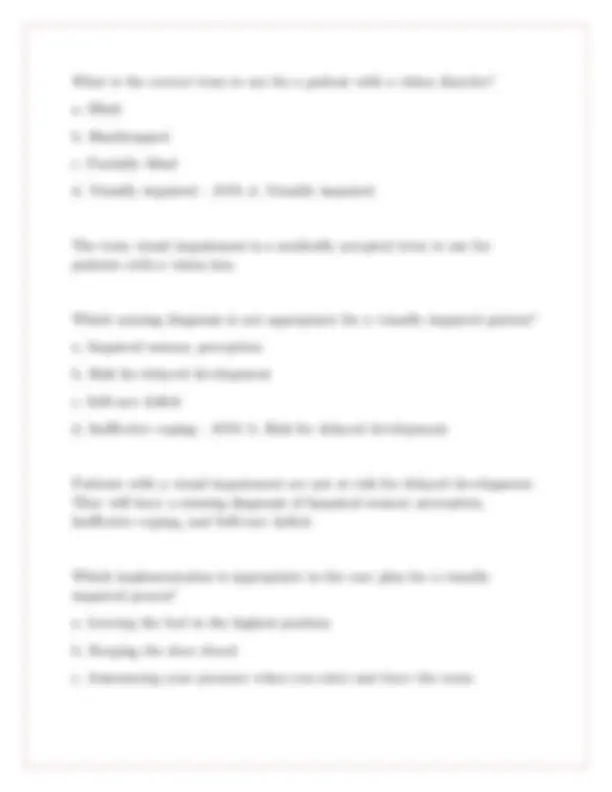
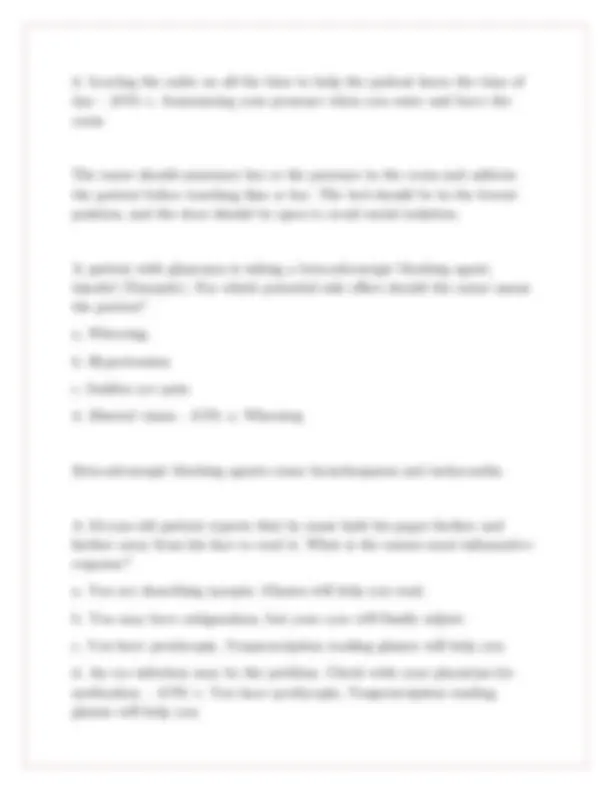
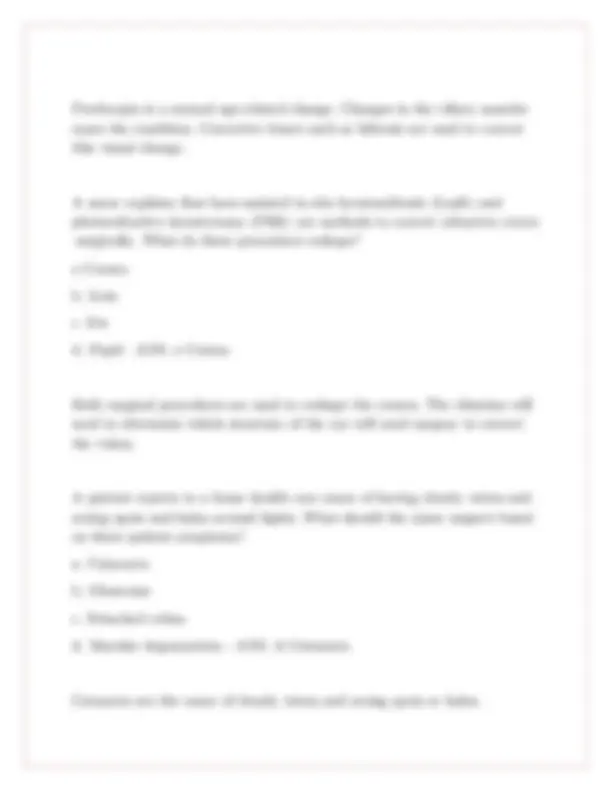
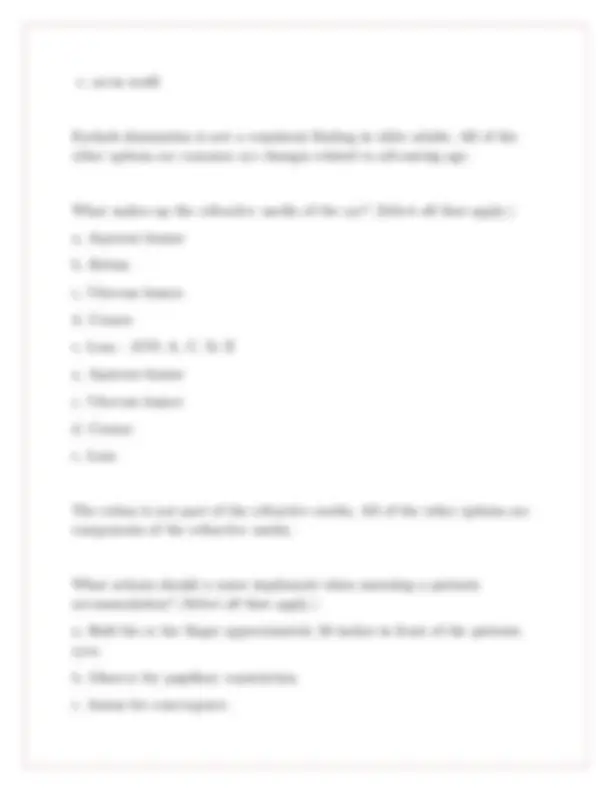
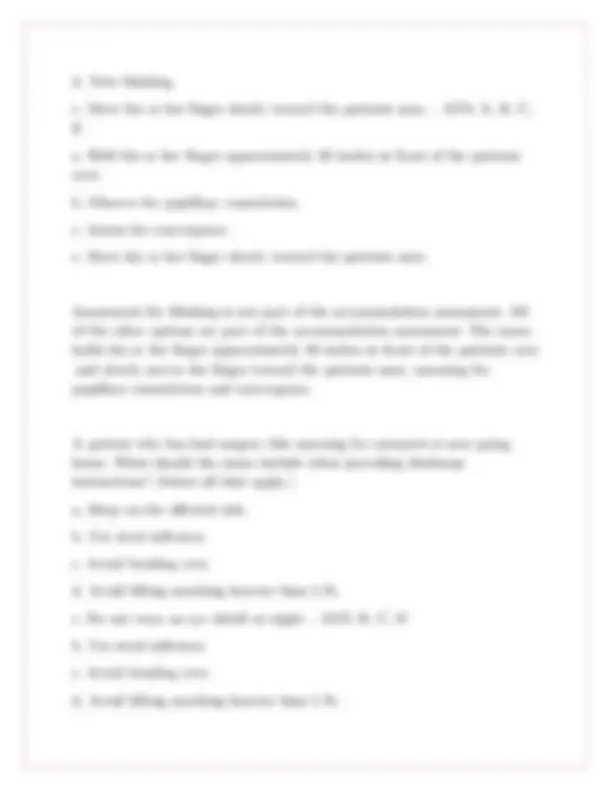
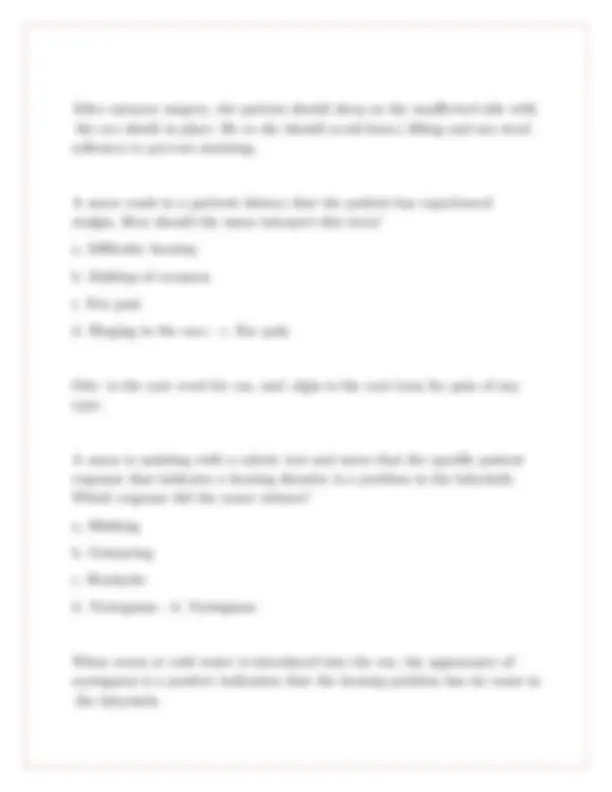
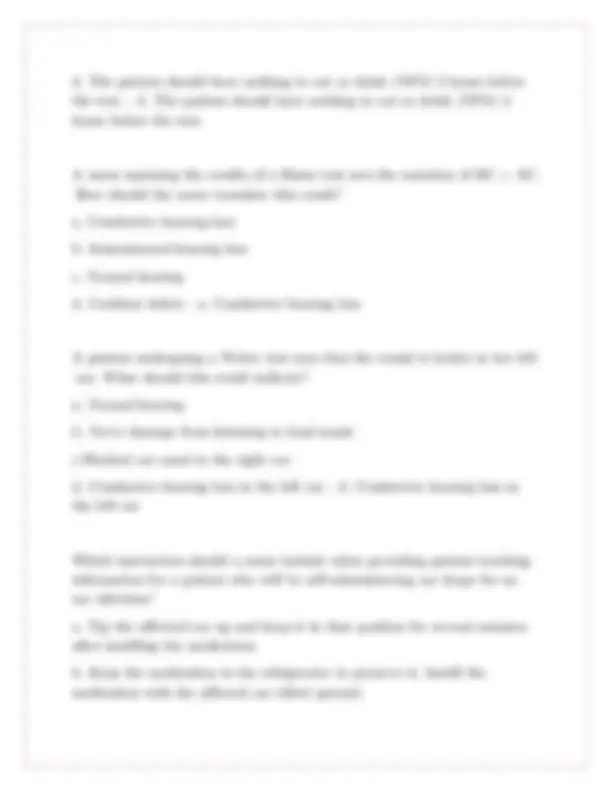
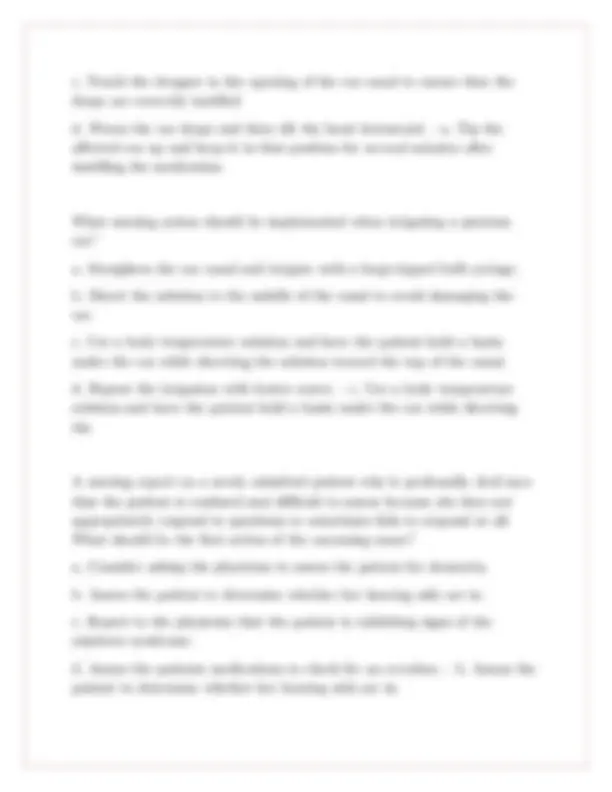
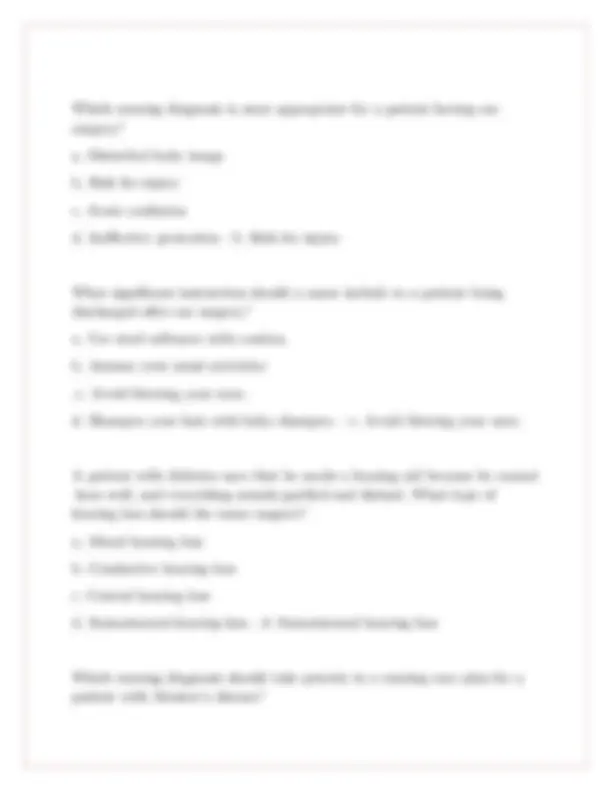
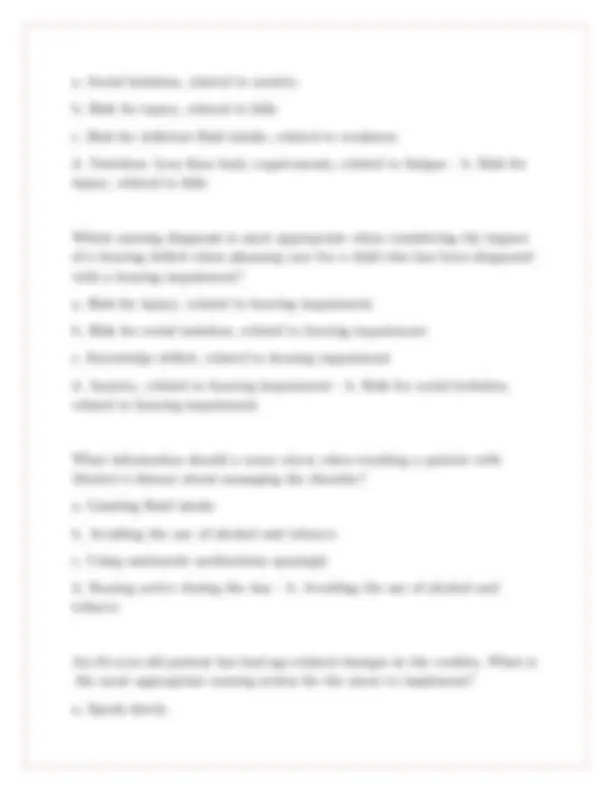
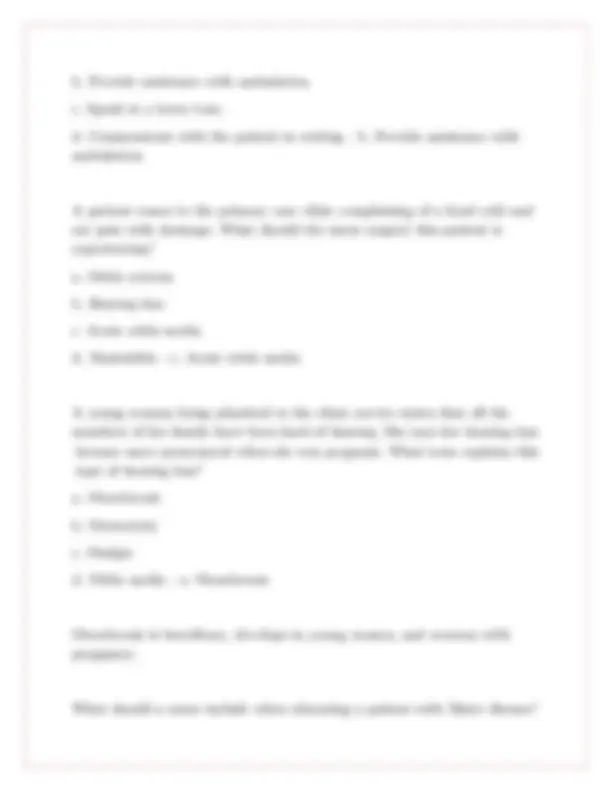
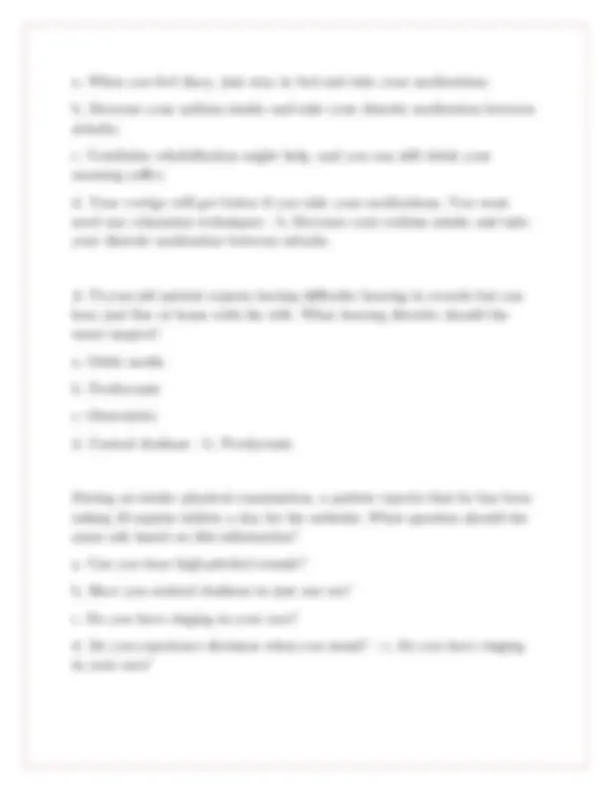
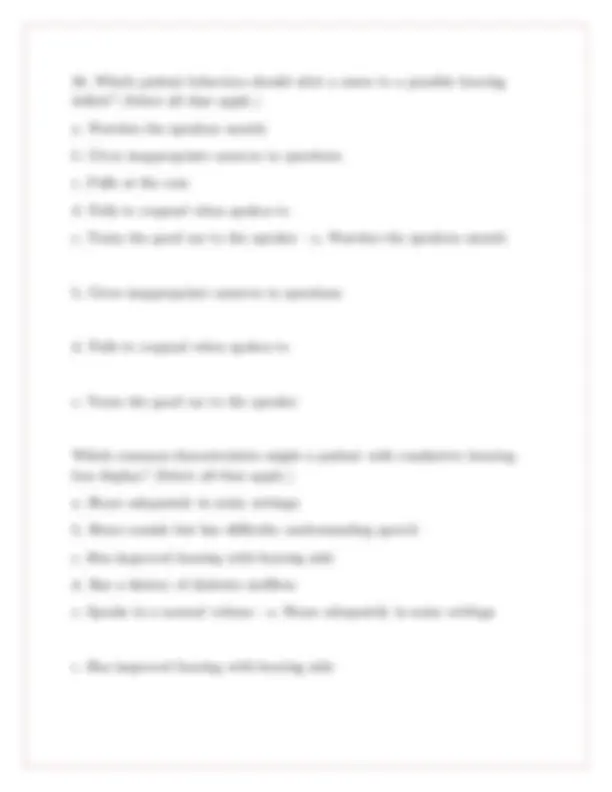
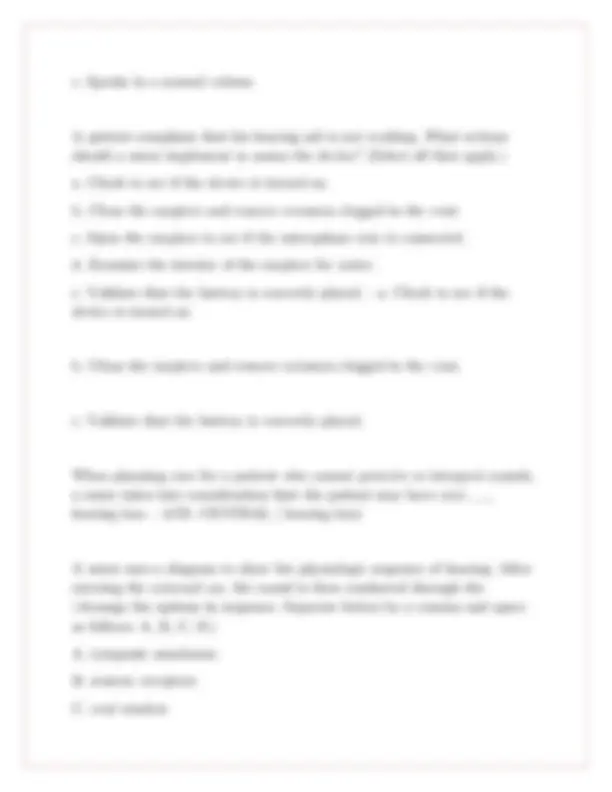



Study with the several resources on Docsity

Earn points by helping other students or get them with a premium plan


Prepare for your exams
Study with the several resources on Docsity

Earn points to download
Earn points by helping other students or get them with a premium plan
Community
Ask the community for help and clear up your study doubts
Discover the best universities in your country according to Docsity users
Free resources
Download our free guides on studying techniques, anxiety management strategies, and thesis advice from Docsity tutors
MS QUIZ 10 Eye and Vision Disorders Hearing and drugs Exam with verified solutions
Typology: Exams
1 / 26

This page cannot be seen from the preview
Don't miss anything!



















A |! 60-year-old |! patient |! who |! has |! had |! an |! enucleation |! asks |! when |! he |! can |! get |! his |! prosthesis |! fitted. |! In |! approximately |! how |! many |! weeks |! should |! this |! patient |! expect |! to |! be |! fitted? a. |! 2 b. |! 4 c. |! 8 d. |! 12 |! - |! ANS: |! B. |! 4 |! [1month] After |! an |! enucleation, |! the |! patient |! is |! fitted |! with |! a |! prosthesis |! in |! 1 |! month A |! patient |! who |! has |! been |! taking |! opioid |! medication |! for |! postoperative |! pain |! exhibits |! pinpoint |! pupils. |! Which |! anatomic |! portion |! of |! the |! eye |! has |! been |! affected |! by |! the |! medication? a. |! Sclera b. |! Retina c. |! Choroid d. |! Bulbar |! conjunctiva |! - |! ANS: |! C. |! Choroid
The |! choroid |! of |! the |! eye |! contains |! the |! pupil |! and |! iris. Which |! portion |! of |! the |! eye |! makes |! it |! possible |! for |! a |! person |! to |! see |! in |! a |! darkened |! environment? a. |! Macula b. |! Rods c. |! Cones d. |! Optic |! nerve |! - |! ANS: |! B. |! Rods The |! eye |! uses |! rods |! to |! accommodate |! to |! dim |! light. |! Cones |! are |! the |! color |! receptors, |! the |! optic |! nerve |! transmits |! all |! sensory |! input |! from |! the |! eye |! to |! the |! brain, |! and |! the |! macula |! is |! an |! oval-shaped |! yellow |! spot |! near |! the |! center |! of |! the |! retina |! that |! mediates |! clear, |! detailed |! vision. When |! being |! interviewed, |! a |! 50-year-old |! patient |! says |! that |! he |! cannot |! see |! the |! newspaper |! as |! well |! as |! he |! used |! to. |! What |! is |! the |! reason |! this |! patient |! vision |! has |! changed |! from |! near |! to |! far? a. |! The |! ciliary |! muscle |! changes |! the |! pupil |! size. b. |! The |! lens |! of |! the |! eye |! changes |! shape |! as |! the |! ciliary |! muscle |! contracts |! and |! relaxes. c. |! Nearsightedness |! has |! set |! in. d. |! Clouding |! of |! the |! vitreous |! humor |! has |! occurred. |! - |! : |! B. |! The |! lens |! of |! the |! eye |! changes |! shape |! as |! the |! ciliary |! muscle |! contracts |! and |! relaxes. Accommodation |! or |! adjustment |! of |! the |! lens |! by |! contraction |! and |! expansion |! of |! the |! ciliary |! muscle |! allows |! an |! individual |! to |! see |! far |! or |! near.
Which |! intraocular |! pressure |! reading |! obtained |! by |! tonometry |! indicates |! a |! patient |! being |! evaluated |! for |! a |! visual |! impairment |! does |! not |! have |! glaucoma? a. |! 18 |! mm |! Hg b. |! 28 |! mm |! Hg c. |! 45 |! mm |! Hg d. |! 52 |! mm |! Hg |! - |! ANS: |! A |! 18 |! mm |! Hg The |! normal |! intraocular |! pressure |! is |! between |! 10 |! and |! 20mm |! Hg. |! If |! the |! patient |! had |! glaucoma, |! the |! intraocular |! pressure |! would |! be |! abnormally |! high. What |! does |! a |! pneumatonometric |! study |! of |! the |! eye |! require? a. |! Regional |! anesthesia b. |! A |! pneumotonometer |! to |! be |! placed |! into |! the |! eye c. |! A |! puff |! of |! air |! directed |! at |! the |! surface |! of |! the |! eye d. |! An |! applanation |! performed |! with |! a |! slit-lamp |! microscope |! - |! ANS: |! C.A |! puff |! of |! air |! directed |! at |! the |! surface |! of |! the |! eye A |! pneumotonometer |! directs |! a |! puff |! of |! air |! at |! the |! surface |! of |! the |! eye, |! measuring |! intraocular |! pressure |! by |! measuring |! the |! resistance |! to |! the |! air. |! The |! eye |! is |! anesthetized |! before |! the |! evaluation. What |! is |! an |! appropriate |! nursing |! action |! to |! implement |! when |! performing |! eye |! irrigation? a. |! Ask |! the |! patient |! to |! tip |! up |! her |! head |! and |! run |! the |! irrigation |! fluid |! over |! her |! open |! eye.
b. |! Direct |! the |! irrigating |! fluid |! from |! the |! inner |! canthus |! to |! the |! outer |! canthus. c. |! Not |! allow |! the |! patient |! to |! blink. d. |! Place |! the |! irrigating |! syringe |! directly |! onto |! the |! corner |! of |! the |! eye |! and |! allow |! the |! fluid |! to |! move |! across |! the |! eye. |! - |! ANS: |! B Direct |! the |! irrigating |! fluid |! from |! the |! inner |! canthus |! to |! the |! outer |! canthus. The |! direction |! of |! the |! flow |! should |! be |! from |! the |! inner |! canthus |! to |! the |! outer |! canthus. What |! information |! should |! a |! nurse |! include |! when |! providing |! information |! to |! a |! patient |! using |! topical |! eye |! medications? a. |! Look |! upward |! and |! drop |! the |! medication |! into |! the |! inner |! canthus. b. |! Pull |! the |! lower |! eyelid |! down |! and |! drop |! the |! medication |! into |! the |! conjunctival |! sac. c. |! Hold |! both |! eyelids |! open |! and |! drop |! the |! medication |! onto |! the |! sclera. d. |! Tilt |! the |! head |! to |! the |! side |! and |! drop |! the |! medication |! into |! the |! outer |! canthus. |! - |! ANS: |! B.Pull |! the |! lower |! eyelid |! down |! and |! drop |! the |! medication |! into |! the |! conjunctival |! sac. The |! eye |! drops |! should |! be |! dropped |! into |! the |! lower |! eyelid, |! and |! the |! nurse |! should |! press |! the |! tear |! duct |! to |! slow |! absorption What |! does |! electroretinography |! measure? a. |! A |! fluorescein |! dye |! is |! injected |! intravenously |! (IV) |! into |! a |! vein |! in |! the |! arm, |! and |! the |! retina |! is |! observed |! as |! the |! dye |! circulates.
a. |! Hold |! the |! visually |! impaired |! person |! by |! his |! or |! her |! nondominant |! arm |! and |! walk |! side |! by |! side. b. |! Hold |! the |! nondominant |! hand, |! wrap |! the |! arm |! around |! his |! or |! her |! waist, |! and |! walk |! side |! by |! side. c. |! Allow |! the |! visually |! impaired |! person |! to |! hold |! the |! helpers |! arm, |! with |! the |! helper |! slightly |! ahead. d. |! Allow |! the |! visually |! impaired |! person |! to |! hold |! the |! shoulder |! of |! the |! helper |! and |! walk |! slightly |! behind |! the |! helper. |! - |! ANS: |! C.Allow |! the |! visually |! impaired |! person |! to |! hold |! the |! helpers |! arm, |! with |! the |! helper |! slightly |! ahead Allowing |! the |! visually |! impaired |! person |! to |! walk |! slightly |! behind |! the |! helper |! and |! holding |! the |! helpers |! arm |! is |! the |! most |! effective |! way |! to |! guide |! someone |! who |! is |! visually |! impaired. A |! newly |! diagnosed |! patient |! with |! macular |! degeneration |! flings |! her |! book |! at |! the |! television |! set |! and |! furiously |! says, |! I |! cant |! read |! this |! blasted |! book, |! and |! I |! cant |! see |! what |! is |! on |! the |! stupid |! TV! |! How |! should |! the |! nurse |! define |! this |! behavior? a. |! Anger |! stage |! of |! grieving b. |! Poor |! impulse |! control c. |! Ineffective |! management |! of |! a |! therapeutic |! regimen d. |! Psychotic |! reaction |! to |! loss |! - |! ANS: |! A. |! Anger |! stage |! of |! grieving Frequently, |! a |! grieving |! process |! accompanies |! the |! realization |! that |! deteriorating |! vision |! and |! ultimate |! blindness |! are |! inevitable |! with |! macular |! degeneration.
What |! is |! the |! correct |! term |! to |! use |! for |! a |! patient |! with |! a |! vision |! disorder? a. |! Blind b. |! Handicapped c. |! Partially |! blind d. |! Visually |! impaired |! - |! ANS: |! d. |! Visually |! impaired The |! term |! visual |! impairment |! is |! a |! medically |! accepted |! term |! to |! use |! for |! patients |! with |! a |! vision |! loss. Which |! nursing |! diagnosis |! is |! not |! appropriate |! for |! a |! visually |! impaired |! patient? a. |! Impaired |! sensory |! perception b. |! Risk |! for |! delayed |! development c. |! Self-care |! deficit d. |! Ineffective |! coping |! - |! ANS: |! b. |! Risk |! for |! delayed |! development Patients |! with |! a |! visual |! impairment |! are |! not |! at |! risk |! for |! delayed |! development. |! They |! will |! have |! a |! nursing |! diagnosis |! of |! Impaired |! sensory |! perception, |! Ineffective |! coping, |! and |! Self-care |! deficit. Which |! implementation |! is |! appropriate |! in |! the |! care |! plan |! for |! a |! visually |! impaired |! person? a. |! Leaving |! the |! bed |! in |! the |! highest |! position b. |! Keeping |! the |! door |! closed c. |! Announcing |! your |! presence |! when |! you |! enter |! and |! leave |! the |! room
Presbyopia |! is |! a |! normal |! age-related |! change. |! Changes |! in |! the |! ciliary |! muscles |! cause |! the |! condition. |! Corrective |! lenses |! such |! as |! bifocals |! are |! used |! to |! correct |! this |! visual |! change. A |! nurse |! explains |! that |! laser-assisted |! in |! situ |! keratomileusis |! (Lasik) |! and |! photorefractive |! keratectomy |! (PRK) |! are |! methods |! to |! correct |! refractive |! errors |! surgically. |! What |! do |! these |! procedures |! reshape? a |! Cornea b. |! Lens c. |! Iris d. |! Pupil |! - |! ANS: |! a |! Cornea Both |! surgical |! procedures |! are |! used |! to |! reshape |! the |! cornea. |! The |! clinician |! will |! need |! to |! determine |! which |! structure |! of |! the |! eye |! will |! need |! surgery |! to |! correct |! the |! vision. A |! patient |! reports |! to |! a |! home |! health |! care |! nurse |! of |! having |! cloudy |! vision |! and |! seeing |! spots |! and |! halos |! around |! lights. |! What |! should |! the |! nurse |! suspect |! based |! on |! these |! patient |! symptoms? a. |! Cataracts. b. |! Glaucoma c. |! Detached |! retina d. |! Macular |! degeneration |! - |! ANS: |! A |! Cataracts. Cataracts |! are |! the |! cause |! of |! cloudy |! vision |! and |! seeing |! spots |! or |! halos.
How |! does |! closed-angle |! glaucoma |! differ |! from |! open-angle |! glaucoma? a. |! The |! onset |! is |! acute. b. |! Trabeculectomy |! is |! the |! initial |! treatment. c. |! Treatment |! can |! be |! conservative. d. |! Intraocular |! pressure |! drops |! suddenly. |! - |! ANS: |! A |! The |! onset |! is |! acute. Closed-angle |! glaucoma |! has |! an |! acute |! onset |! with |! eye |! pain |! and |! other |! systemic |! symptoms, |! such |! as |! nausea |! and |! vomiting. |! Reducing |! the |! intraocular |! pressure |! is |! an |! ocular |! emergency. What |! is |! the |! cause |! of |! glaucoma? a. |! Cloudiness |! in |! the |! lens b. |! Increase |! in |! intraocular |! pressure c. |! Failed |! eye |! surgery d. |! Retinal |! tears |! - |! ANS: |! B |! Increase |! in |! intraocular |! pressure Glaucoma |! is |! caused |! by |! an |! increase |! in |! intraocular |! pressure. A |! patient |! in |! the |! emergency |! department |! complains |! of |! severe |! pain |! in |! his |! eye |! and |! is |! seeing |! halos |! around |! lights |! and |! feeling |! nauseous. |! Which |! diagnosis |! should |! the |! nurse |! suspect? a. |! Open-angle |! glaucoma b. |! Angle-closure |! glaucoma c. |! Cataracts
|! e. |! arcus |! senili Eyelash |! diminution |! is |! not |! a |! consistent |! finding |! in |! older |! adults. |! All |! of |! the |! other |! options |! are |! common |! eye |! changes |! related |! to |! advancing |! age. What |! makes |! up |! the |! refractive |! media |! of |! the |! eye? |! (Select |! all |! that |! apply.) a. |! Aqueous |! humor b. |! Retina c. |! Vitreous |! humor d. |! Cornea e. |! Lens |! - |! ANS: |! A, |! C, |! D, |! E a. |! Aqueous |! humor c. |! Vitreous |! humor d. |! Cornea e. |! Lens The |! retina |! is |! not |! part |! of |! the |! refractive |! media. |! All |! of |! the |! other |! options |! are |! components |! of |! the |! refractive |! media. What |! actions |! should |! a |! nurse |! implement |! when |! assessing |! a |! patients |! accommodation? |! (Select |! all |! that |! apply.) a. |! Hold |! his |! or |! her |! finger |! approximately |! 20 |! inches |! in |! front |! of |! the |! patients |! eyes. b. |! Observe |! for |! pupillary |! constriction. c. |! Assess |! for |! convergence.
d. |! Note |! blinking. e. |! Move |! his |! or |! her |! finger |! slowly |! toward |! the |! patients |! nose. |! - |! ANS: |! A, |! B, |! C, |! E a. |! Hold |! his |! or |! her |! finger |! approximately |! 20 |! inches |! in |! front |! of |! the |! patients |! eyes. b. |! Observe |! for |! pupillary |! constriction. c. |! Assess |! for |! convergence. e. |! Move |! his |! or |! her |! finger |! slowly |! toward |! the |! patients |! nose. Assessment |! for |! blinking |! is |! not |! part |! of |! the |! accommodation |! assessment. |! All |! of |! the |! other |! options |! are |! part |! of |! the |! accommodation |! assessment. |! The |! nurse |! holds |! his |! or |! her |! finger |! approximately |! 20 |! inches |! in |! front |! of |! the |! patients |! eyes |! and |! slowly |! moves |! the |! finger |! toward |! the |! patients |! nose, |! assessing |! for |! pupillary |! constriction |! and |! convergence. A |! patient |! who |! has |! had |! surgery |! this |! morning |! for |! cataracts |! is |! now |! going |! home. |! What |! should |! the |! nurse |! include |! when |! providing |! discharge |! instructions? |! (Select |! all |! that |! apply.) a. |! Sleep |! on |! the |! affected |! side. b. |! Use |! stool |! softeners. c. |! Avoid |! bending |! over. d. |! Avoid |! lifting |! anything |! heavier |! than |! 5 |! lb. e. |! Do |! not |! wear |! an |! eye |! shield |! at |! night. |! - |! ANS: |! B, |! C, |! D b. |! Use |! stool |! softeners. c. |! Avoid |! bending |! over. d. |! Avoid |! lifting |! anything |! heavier |! than |! 5 |! lb.
A |! 75-year-old |! patient |! has |! normal |! age-related |! changes |! in |! his |! ear. |! What |! change |! should |! not |! be |! considered |! a |! normal |! change |! in |! the |! aging |! patient? a. |! Dry |! and |! wrinkled |! skin |! on |! the |! auricle b. |! Otitis |! externa c. |! Dry |! cerumen d. |! Hair |! in |! the |! ear |! canal |! - |! b. |! Otitis |! externa When |! making |! an |! initial |! assessment |! on |! a |! patient |! with |! a |! hearing |! deficit, |! the |! patient |! reports |! that |! he |! often |! feels |! off |! balance |! and |! is |! dizzy |! when |! he |! stands |! up. |! Which |! diagnosis |! might |! explain |! these |! symptoms? a. |! Sinus |! infection b. |! Rubella c. |! Otalgia d. |! Presbycusis |! - |! a. |! Sinus |! infection A |! 94-year-old |! patient |! is |! receiving |! gentamicin |! sulfate |! (Garamycin) |! in |! a |! continuous |! intravenous |! (IV) |! infusion. |! The |! nurse |! adds |! to |! the |! nursing |! care |! plan |! the |! diagnosis |! Risk |! for |! injury. |! What |! nursing |! action |! should |! be |! implemented? a. |! Pull |! side |! rails |! in |! place. b. |! Assist |! with |! ambulation. c. |! Measure |! intake |! and |! output. d. |! Provide |! for |! a |! possible |! seizure. |! - |! c. |! Measure |! intake |! and |! output.
A |! 75-year-old |! patient |! reports |! to |! a |! nurse |! that |! although |! she |! has |! cleaned |! her |! ears |! with |! cotton-tipped |! applicators |! for |! weeks, |! she |! still |! cannot |! hear |! her |! television |! unless |! the |! volume |! is |! loud, |! and |! she |! misses |! a |! great |! deal |! of |! conversations. |! What |! should |! the |! nurse |! anticipate |! when |! examining |! her |! ears? a. |! Otitis |! externa b. |! Purulent |! drainage c. |! Dry |! cerumen |! across |! the |! canal d. |! Pearly |! tympanic |! membrane |! - |! c. |! Dry |! cerumen |! across |! the |! canal A |! patient |! reports |! that |! her |! hearing |! loss |! has |! become |! more |! severe |! over |! the |! past |! 3 |! months. |! The |! clinic |! nurse |! makes |! arrangements |! for |! an |! evaluation |! for |! a |! hearing |! aid. |! What |! health |! care |! provider |! should |! provide |! this |! service? a. |! Otologist b. |! Otolaryngologist c. |! Audiometrist d. |! Audiologist |! - |! d. |! Audiologist Audiologists |! assess |! patients |! for |! hearing |! aids. |! The |! other |! specialists |! treat |! ear, |! nose, |! and |! throat |! (ENT) |! disorders. When |! a |! patient |! has |! a |! suspected |! vestibular |! disorder, |! the |! physician |! orders |! an |! electronystagmography |! test. |! Which |! instruction |! should |! the |! nurse |! include |! when |! educating |! the |! patient |! about |! this |! test? a. |! Use |! tea |! or |! coffee |! on |! the |! morning |! of |! test. b. |! Electrodes |! will |! be |! placed |! on |! the |! scalp. c. |! Air |! will |! be |! blown |! into |! the |! external |! ear.
c. |! Touch |! the |! dropper |! to |! the |! opening |! of |! the |! ear |! canal |! to |! ensure |! that |! the |! drops |! are |! correctly |! instilled d. |! Warm |! the |! ear |! drops |! and |! then |! tilt |! the |! head |! downward. |! - |! a. |! Tip |! the |! affected |! ear |! up |! and |! keep |! it |! in |! that |! position |! for |! several |! minutes |! after |! instilling |! the |! medication. What |! nursing |! action |! should |! be |! implemented |! when |! irrigating |! a |! patients |! ear? a. |! Straighten |! the |! ear |! canal |! and |! irrigate |! with |! a |! large-tipped |! bulb |! syringe. b. |! Direct |! the |! solution |! to |! the |! middle |! of |! the |! canal |! to |! avoid |! damaging |! the |! ear. c. |! Use |! a |! body |! temperature |! solution |! and |! have |! the |! patient |! hold |! a |! basin |! under |! the |! ear |! while |! directing |! the |! solution |! toward |! the |! top |! of |! the |! canal. d. |! Repeat |! the |! irrigation |! with |! hotter |! water. |! - |! c. |! Use |! a |! body |! temperature |! solution |! and |! have |! the |! patient |! hold |! a |! basin |! under |! the |! ear |! while |! directing |! the A |! nursing |! report |! on |! a |! newly |! admitted |! patient |! who |! is |! profoundly |! deaf |! says |! that |! the |! patient |! is |! confused |! and |! difficult |! to |! assess |! because |! she |! does |! not |! appropriately |! respond |! to |! questions |! or |! sometimes |! fails |! to |! respond |! at |! all. |! What |! should |! be |! the |! first |! action |! of |! the |! oncoming |! nurse? a. |! Consider |! asking |! the |! physician |! to |! assess |! the |! patient |! for |! dementia. b. |! Assess |! the |! patient |! to |! determine |! whether |! her |! hearing |! aids |! are |! in. c. |! Report |! to |! the |! physician |! that |! the |! patient |! is |! exhibiting |! signs |! of |! the |! sundown |! syndrome. d. |! Assess |! the |! patients |! medications |! to |! check |! for |! an |! overdose. |! - |! b. |! Assess |! the |! patient |! to |! determine |! whether |! her |! hearing |! aids |! are |! in.
Which |! nursing |! diagnosis |! is |! most |! appropriate |! for |! a |! patient |! having |! ear |! surgery? a. |! Disturbed |! body |! image b. |! Risk |! for |! injury c. |! Acute |! confusion d. |! Ineffective |! protection |! - |! b. |! Risk |! for |! injury What |! significant |! instruction |! should |! a |! nurse |! include |! to |! a |! patient |! being |! discharged |! after |! ear |! surgery? a. |! Use |! stool |! softeners |! with |! caution. b. |! Assume |! your |! usual |! activities .c. |! Avoid |! blowing |! your |! nose. d. |! Shampoo |! your |! hair |! with |! baby |! shampoo. |! - |! c. |! Avoid |! blowing |! your |! nose. A |! patient |! with |! diabetes |! says |! that |! he |! needs |! a |! hearing |! aid |! because |! he |! cannot |! hear |! well, |! and |! everything |! sounds |! garbled |! and |! distant. |! What |! type |! of |! hearing |! loss |! should |! the |! nurse |! suspect? a. |! Mixed |! hearing |! loss b. |! Conductive |! hearing |! loss c. |! Central |! hearing |! loss d. |! Sensorineural |! hearing |! loss |! - |! d. |! Sensorineural |! hearing |! loss Which |! nursing |! diagnosis |! should |! take |! priority |! in |! a |! nursing |! care |! plan |! for |! a |! patient |! with |! Meniere's |! disease?